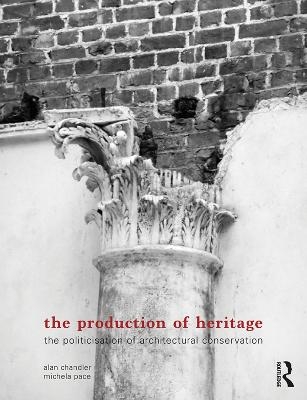
The Production of Heritage
Routledge (Verlag)
978-0-367-07801-0 (ISBN)
In this important book, the authors unpack the theoretical and practical issues around the development of heritage sites, critically dissecting key conservation benchmarks such as the ICOMOS guidelines, BS 7913 and the RIBA Conservation Plan of Work to reveal the mechanics of heritage guidance, its advantages and conceptual limitations.
Underpinned by an active understanding of the conservation philosophy of William Morris, the book presents five case studies from the UK and North and South America that speak about different facets of heritage value, such as urban identity, commodification, authenticity, materiality and heritage as an intellectual and ethical framework. Heritage is never neutral; its definition is privileged yet its influence is political. Art, landscape and archaeology all offer examples of how the operational ideas of adjacent disciplines can influence an integrated idea of heritage conservation, and how this is communicated in order to determine significance and share in its custodianship.
This book provides insights into how to identify and challenge these limitations, expanding inclusion by describing tactics for changing how people can relate to and build on the past. Clearly written for all levels of readership within the conservation professions and community custodians of heritage buildings and places, the book provides strategies and tactics for understanding the heritage significance of materials, their fabrication, detail and use. The narratives that historic fabric contains can help shape the meaningful involvement of local people, providing a roadmap for those navigating the double-bind of using the past to underpin the future.
Alan Chandler is a founding director of the architectural practice Arts Lettres Techniques with Luisa Auletta, working consistently on the interface between contemporary design and conservation since 1993, when fabric formed concrete casts weighing several tonnes were taken from the portico of Hawksmoor's St George's Church in Bloomsbury to create a site-specific installation while studying at the Architectural Association. This early engagement with questioning material and heritage value has persisted, with expertise in conservation accreditation and award-winning projects in the UK and Chile maintaining a focus on how politics and cultural perception connect with material and philosophical conservation. Examining for the RIBA Conservation Register began at its inception in 2011, followed by membership of the RIBA Conservation Committee and Steering Group, has allowed a perspective on the culture of professionalism, the criticism of which in this book should be balanced with a genuine respect for the knowledge and commitment of many professionals within the field, and an acknowledgement that the RIBA has made a genuine investment into conservation practice, supported by dedicated and intelligent staff within the organisation. The aim of the dissection is to discover what is missing, not what is wrong. He is a reader in architecture and currently leads research in architecture, computing and engineering at the University of East London. Michela Pace is a researcher at the IUAV University of Venice in the field of urbanism; she has previously worked and collaborated with universities including UEL London, PoliTo Turin and PoliMi Milan, UH Hasselt and Tongji University Shanghai. She studied the rising centrality of the ’heritage’ rhetoric within processes of urban financialization worldwide, and the use of notions of memory, legacy, patrimony and tradition inside city marketing. Heritage, in particular, was observed in relation to real estate activities and the phenomena of land privatisation and gentrification in Western and Eastern global cities. At the same time, as an architect, she deepened her experience of community-based research, collaborating with a different spectrum of partners and clients for the making of local projects. These include local communities and schools, councils and policymakers, international NGOs, charitable foundations and private clients. Merging the observations of ‘heritage’ promotion and protection at the global and local scale has the ability to disclose those mechanisms able to promote an idea of city, and the language and the rules able to distribute it. What is at stake is not only the concept of past and the power of history, but also the collective ability to imagine alternative futures.
Overview and Book Structure 1. Introduction - Heritage conservation in a neoliberal culture 1.1 Heritage as narrative – The value of selection 1.2 History as an unfolding process – Style or substance 1.3 Frameworks for heritage, education and training 1.4 The professional landscape – How is heritage framed for the architects who frame heritage? 2. The Production of Heritage – Philosophies of fabrication 2.1 Palacio Pereira, Santiago, Chile – 2012/2019 2.2 Defining the strategy 2.3 After the strategy, the tactics 3. Place: material and the urban imaginary 3.1 Covent Garden 3.2 Battersea Power Station 4. The Memory of Surfaces – The physical nature of visual memory and its illusion 4.1 Artificial Realities: the Courtauld Institute East-Wing Biennial – 2016/17 4.2 Clandon Park and the ‘phoenix concept’ 5. History and Material Significance – Craft and a sense of place 5.1 St. Pancras Church, London – 2016 5.2 The Whitechapel Art Gallery, London 6. As Found – Tactics for a way out of the heritage trap 6.1 Conservation Plan and the mechanics of conservation empathy 6.2 Learning - from Landscape Archaeology and Art Conclusions Index
| Erscheinungsdatum | 23.12.2019 |
|---|---|
| Zusatzinfo | 1 Line drawings, color; 71 Halftones, color; 9 Halftones, black and white; 72 Illustrations, color; 9 Illustrations, black and white |
| Verlagsort | London |
| Sprache | englisch |
| Maße | 189 x 246 mm |
| Gewicht | 734 g |
| Themenwelt | Kunst / Musik / Theater |
| Geisteswissenschaften ► Geschichte ► Hilfswissenschaften | |
| Technik ► Architektur | |
| Technik ► Bauwesen | |
| ISBN-10 | 0-367-07801-5 / 0367078015 |
| ISBN-13 | 978-0-367-07801-0 / 9780367078010 |
| Zustand | Neuware |
| Informationen gemäß Produktsicherheitsverordnung (GPSR) | |
| Haben Sie eine Frage zum Produkt? |
aus dem Bereich


